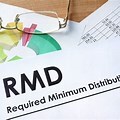
The retirement account is no place to hide money from taxes because eventually, the IRS will come for their even share. RMDs stands for a required minimum distribution (RMD), which refers to the minimum amount of money a taxpayer must take out of a retirement account. These retirement accounts include SEP, SIMPLE individual retirement account (IRA), traditional IRA, employer-sponsored retirement plan, and qualified retirement plan. The official age that enables retirees to withdraw from their contribution was changed from 70½ to 72 years in 2022. The account holder can take money from the account by April 1 after clocking 72. Each year, the retiree is to take the RMDs from the retirement account using the RMD calculator.
RMDs are fixed on tax-deferred accounts with money set aside for many years without tax contributions or gains. The IRS places a minimum RMDs to ensure taxpayers don't defer tax on the account forever. RMDs are considered under ordinary income tax except for Roth accounts. Calculating RMDs can be confusing because of the many factors involved, such as marital status, the age of the spouse if married and whether the account holder is the original holder of the IRA account.
However, taxpayers can refer to their account holder – bank, broker, or plan sponsor to help calculate the RMDs. Taxpayers with several accounts subject to RMDs must calculate the amount to pay separately.
The business can be tricky for an inherited IRA account, and it is something you need help to figure out. You could skip the RMDs if you inherited a small IRA balance. You can withdraw all the funds, pay the taxes and invest or spend the rest. However, call a tax professional if the inherited IRA balance is significant.
In cases where you do not have the Required Minimum Distribution calculator, you can calculate the RMDs by dividing the IRA balance on Dec 31 by the distribution period (life expectancy). That is:
Total Account Balance ÷ Life Expectancy Factor = RMD Amount
Example: $100,000.00 (Account Balance) ÷ 23.8 (Age 74) = 4,201.68 (RMD Amount)
There are penalties for every missing tax return, which applies to RMDs. The IRS will issue you harsh penalties of up to 50% of the shortfall. For example, if the law mandates you to take $15,000 and you take $11,000, it means you'll pay income tax on the shortfall and still remit the remaining $2,000 to the IRS. However, smart taxpayers seek relief from the IRS to mitigate the punishment. The relief is filed on Form 5329, explaining the reason for the omission.
Work
If you're still working above age 72 and do not own up to 5% of the company, you can evade RMDs by waiting till retirement.
Rollover to a Roth Account to Avoid RMDs
For taxpayers with Roth 401(k)s, you can roll over your funds to a Roth IRA account since it has no RMDs for the original owner. However, you must be 59½ or older with at least one Roth IRA existing for more than five years. The rollover is tax-free for qualified accounts.
Consider a Qualified Longevity Annuity Contract
The (QLAC) qualified longevity annuity contract is an excellent choice for lowering RMDs and deferring taxes. The account allows you to take up to $130,000 or 25% of the balance, whichever is higher, to invest in a particular account called deferred income annuity. The QLAC requires taxpayers to invest a token in advance for payouts that will be possible after many years. The money in the QLAC is not considered an IRA balance and does not attract RMDs. However, your payment is taxable because the account is longevity insurance and starts at age 85.
FOR MORE INFORMATION ON HOW PAT RASKOB CAN BEST HELP YOU WITH YOUR TAX FILING NEEDS, PLEASE CLICK THE BLUE TAB ON THIS PAGE.
THANKS FOR VISITING.
Pat Raskob